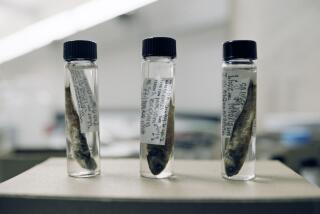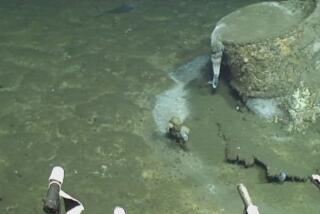The Lingering Effects of Exxon Valdez
- Share via
Hidden pools of oil left over from the Exxon Valdez spill 14 years ago continued to damage the Alaskan coastal environment for a decade, killing pink salmon eggs and retarding the population growth of sea otters, harlequin ducks and other wildlife, a new study says.
The 14-year study published today in the journal Science points out that the effects of the 11-million gallon spill into Prince William Sound extended well beyond the initial deaths of 250,000 seabirds, 2,800 otters and 300 harbor seals.
The residual oil became particularly toxic and continued to harm the coastal environment for far longer than expected, the study said. These oily pockets are still tucked beneath boulders or buried below gravel and mussel beds and have escaped sunlight, oxygen and waves that normally would break them down, researchers say.
“Because the Exxon Valdez spill happened in a biological wonderland of sea otters and harlequin ducks, there has been a huge amount of research,” said Charles H. Peterson, the paper’s lead author and a University of North Carolina marine biologist. “Things we have dismissed as sub-lethal effects actually translate into significant decline in wildlife.”
For instance, the study compared the recovery of sea otters on the heavily oiled shores of northern Knight Island with another island in the region that was not coated during the catastrophic spill. The population of sea otters that forages around Knight Island remains half of what it was before the spill, while the population at the other island doubled from 1995 to 1998.
Otters suffer chronic exposure to toxic oil residue by eating contaminated clams and by digging around with their paws into contaminated sandy ocean bottoms, according to the study.
Written by seven university and government scientists, the report was attacked as a bunch of “cartoon depictions” by Exxon Mobil Corp. officials before its release.
“What science has learned in Alaska and elsewhere is that while oil spills can have acute short-term effects, the environment has remarkable powers of recovery,” said Frank Sprow, Exxon Mobil’s vice president of safety, health and the environment.
After the cleanup of the sound, which cost Exxon Mobil $2.2 billion, and environmental studies and conservation programs, which cost the company an additional $1 billion, it’s clear that any remaining oil has been safely encapsulated, he said.
“If it was leaching into the environment in ecologically meaningful quantities, it would be gone after 14 years,” Sprow said. “You simply can’t have it both ways.”
The study, which included representatives of the National Marine Fisheries Service, the U.S. Geological Survey and the U.S. Fish and Wildlife Service, notes that “disagreements exist” between scientists funded by Exxon and those funded by the government. Furthermore, the answers to some ecological questions remain uncertain.
“Nevertheless,” the study’s authors wrote, “these uncertainties do little to diminish the general conclusions: oil persisted beyond a decade in surprising amounts and in toxic forms ... and had long-term impacts at the population level.”
The study focused on harlequin ducks, because they are known to remain true to particular stretches of coastline and feed largely on snails and clams. The authors found that far more adult females died during the winters of 1995 to 1998 on shores that had once been covered with oil than did female ducks on shorelines untouched by the spill. They also found evidence -- through a detoxification enzyme -- in the ducks’ bloodstream that they were still showing signs of exposure nine years later.
One particularly disturbing finding in the study was that partially weathered oil appeared to be more toxic to fish than when it was fresh.
Combining lab experiments with field work, the scientists found that this highly toxic residual oil killed the embryos of pink salmon for at least four years after the spill. Pink salmon, which lay about half their eggs near the mouths of streams, are a key part of the food web in Alaska, including a prominent part of the diet for resident killer whales.
“Oil is different over time,” Peterson said. “The stuff that is left over is extremely toxic, even at very low levels.”
He said that when scientists assess the risks of spills in the future, they will have to give greater thought to the long-term effects, because oil’s lasting toxicity can cause significant harm even in small amounts.
More to Read
Sign up for Essential California
The most important California stories and recommendations in your inbox every morning.
You may occasionally receive promotional content from the Los Angeles Times.










